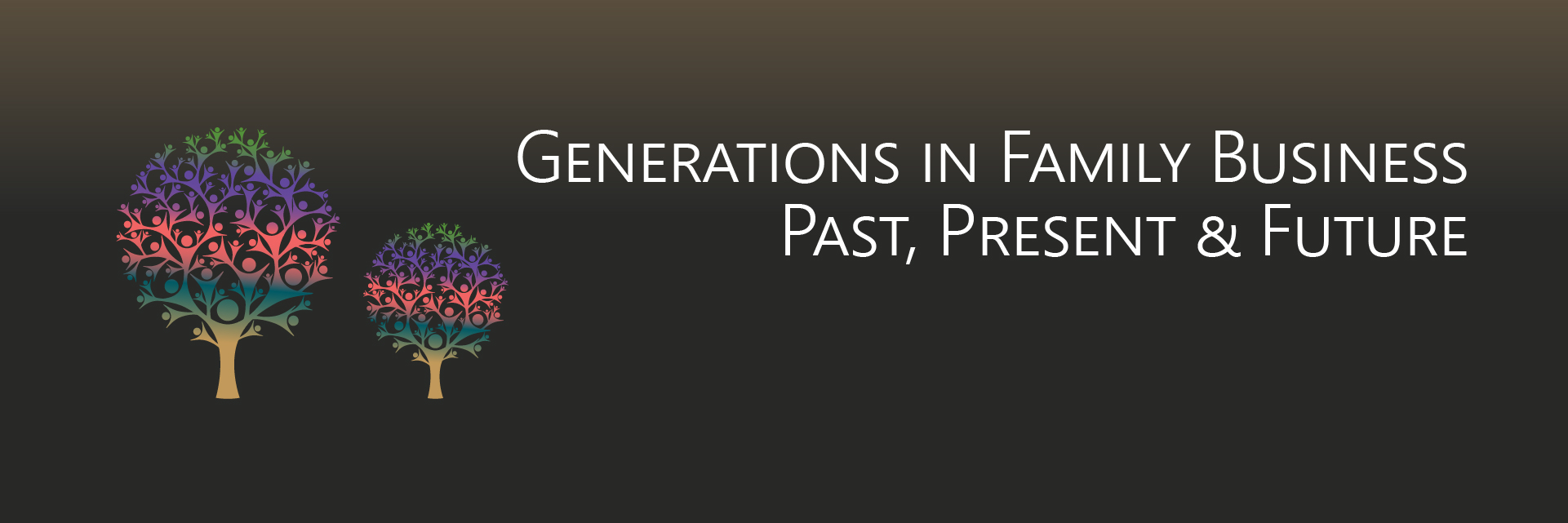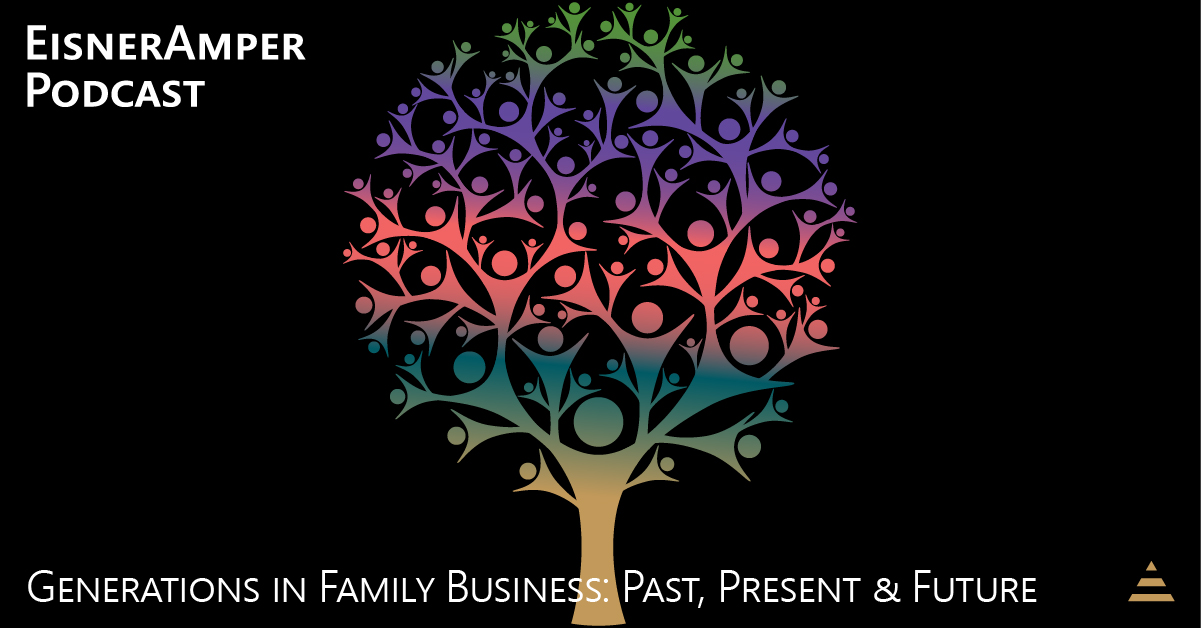
Succession Planning Process: Governance
- Published
- Nov 4, 2019
- Share
Matt Kerzner and Tim Schuster discuss the second step in the process for succession planning, Governance.
Transcript
Tim Schuster: Welcome to our podcast for “Generations in Family Business: Past, Present, and Future.” Our hosts for this podcast are myself, Tim Schuster, and I'm a senior manager in EisnerAmper’s Center for Family Business Excellence and along with us, as always, our good friend …
Matt Kerzner: … Matt Kerzner, I’m a director in the Center for Family Business Excellence.
TS: So we're taking our listeners through the process that we do here in the Center for Family Business Excellence for succession planning. Matt, if you wouldn't mind, let's tee this off by reminding our listeners what the six steps are.
MK: The first step, Tim, is the transition to exit strategy, which we just did a podcast on. The second step is governance. The third step is growth and evaluation, the value enhancement. The fourth one is execution and accountability. The fifth one is leadership development, and the final one is the actual succession transition—the actual endgame.
TS: Let's start by jumping into governance and family systems. What do you typically do when you get through the first phase, we talked about transition and exit strategies. How does governance and family systems look?
MK: Great question Tim. It's really important that when we're working with family businesses or tightly held businesses, when they're going through a succession planning process is really looking at the planning and making sure that the family needs and the business needs are balanced. Owners need to balance both those needs. The key is finding the right balance. What does your family want in this?
Do they want to be actively involved? Is someone in the family going to actually come in and run it, be at the helm? Or is this going to be the first time you're having a non-family member sitting at the helm of the business? You really have to put together some governance for the family and ownership to make sure that the values, the mission, the goals are what the family wants.
TS: Yes, that makes complete sense. So is there any other steps that they go through? I'm thinking of estate planning, and so on and so forth. What does that look like?
MK: That's another great question. In the family governance and family systems, there are a bunch of things that the family and the owners can do to get ready. The first one is, I already mentioned aligning the business and family interests. What's important for the family, what's important for the owners, what's important for the actual business to run. Who are the right key people?
After that it gets into estate planning. Do you have documents in order? Who gets the business, and who gets the estate? Let's say, for example, you have four siblings, two of them are in the business running it and two are owners but are not involved. Or maybe they're not involved at all. Maybe they don't even have ownership, but let's say, for example, I'm the first generation and I'm going to now pass this onto my children. I'm going to go through the succession planning process. The question that I'm thinking about as an owner might be who's getting the business? And then am I going to be equal or not be so equal? Who's going to get my estate, and how do I try to equalize this out amongst my family? So really getting your estate plan in order, getting your documents together, making sure that you're dotting the I’s and crossing your T’s and making sure your wishes are known.
TS: That could be a prickly area for families just because they do have to weigh out these options. I think a common theme when we discussed this with people is the earlier the better. This is also something, too, that's fluid in nature. This is something that maybe a decision was made 10 years ago and all of a sudden may not hold true now.
MK: That's great that you just said that. That's a great segue to the next thing regarding governance and family systems. Are your agreements up to date? When was the last time you looked at them? It could be 10 years ago, like you said. So when I say are the agreements up to date, for example, if one's going to buy out a sibling, how does that operate? What does it look like? How do you make tough decisions? Is your operating agreement or your…
TS: It could be buy/sell or it could be anything, right?
MK: Yes, so the buy/sell agreement is very important. It's really important to make sure your documents are in order. You have a will. Do you have life insurance policies in place? It's really making sure all your agreements are up-to-date. Another one that I like to think about is when, let's say, father and mother own the business and they're transitioning it to their children, two or three children. Do they have, I call it the psychological contract, or what we call the sibling code of conduct? How does the next generation make decisions? How do they debate and resolve conflict? How do they, behind closed doors, really work out the minutia but when they open up the doors they are one voice? So making sure your agreements and psychological contracts are up to date is very, very critical.
The next one is when a transition happens and it goes to a non-family member. One of the things that we help families do is actually develop a family council so they actually could still be involved in the business. Put some processes together on how to make decisions as a family and really develop that format and governance so they are injecting the family values into the business, even though they're not actively involved anymore.
TS: Make sense. It's their baby, right? It's how to make sure that the voices are still there. This was my business at one point, but I understand the reigns have changed.
MK: Another one, Tim, is when the succession planning process happens and you're putting some governance together, it might be, do you need to bring in either a fiduciary board or an advisory board to help. If you're transitioning this to the next generation or to a non-family member, it's really important that there's a sounding board that can hold that CEO accountable. There's a difference between a fiduciary board and an advisory board, and we can get into that at a later date, but it's really important that a family-owned business really thinks about bringing in some external and internal folks, family members to be part of this advisory board to help navigate the next phase.
And then the last one is policies and procedures for the family. When family members wants to enter the business, how do they enter the business? If they're not performing in the business, how do you address them? Putting together some governance and family systems actually can help the outgoing CEO or owner feel comfortable transitioning the business. Knowing that there's either ground rules or policies and procedures that the family follows. This is where a family council can get very exciting because they actually develop that constitution and policies.
TS: I could see that being actually a lot of fun for a family to go through that process and memorialize it. That's huge. Matt, this has been phenomenal information, but let’s tee up the listeners for the next in our series. Let's call it growth value and enhancements.
MK: When it cuts into growth and value enhancement, we're going to talk about that in our next podcast. What does the business need to look like in five to 10 years? What's that strategic roadmap? How are you growing the business? How are you doing things better, faster with quality, that operate efficiently? And then the last one is do you have your bench strength? Who's ready now? Who's ready in three years? Who's ready in five years? When we get into that podcast we're really going to hunker down and that's going to be linked to the podcast that we did for the strategic roadmap.
TS: Well I'm looking forward to discussing that with you. That's going to be a fun one. Matt, thank you so much for coming here today, as always. And thank you for listening to “Generations in Family Business: Past, Present, and Future” as part of the EisnerAmper podcast series. If you have any questions or there's a topic you'd like us to cover, email us at contact@eisneramper.com. Visit eisneramper.com for more information on this and a host of other topics. We look forward to have you listen in on our next EisnerAmper podcast.
Also Available On
More in this Series

Succession Planning Process: Roadmap to Successful Succession

Succession Planning Process: Transition & Exit Strategy

Succession Planning Process: Growth and Values

Succession Planning Process: Execution & Accountability

Succession Planning Process: Leadership & Development
What's on Your Mind?
Start a conversation with Timothy
Receive the latest business insights, analysis, and perspectives from EisnerAmper professionals.











